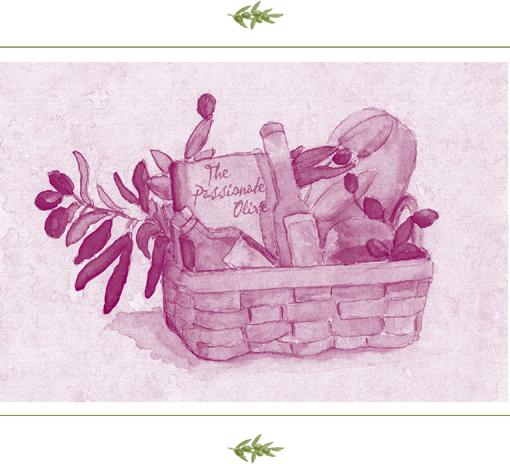The Passionate Olive (19 page)
Read The Passionate Olive Online
Authors: Carol Firenze

88)
CONSECRATE ALTARS, CHURCHES, CHALICES, AND BELLS
To “consecrate” means to make holy or set apart for God’s purposes. Once again, olive oil is the base oil used in the consecration of altars and church buildings (Exodus 29:7, Luke 4:18). In addition, this chrism oil is also used to consecrate chalices and patens (the plates for holding the bread in a Eucharistic service) and to bless new bells prior to their being placed in church bell towers.
89)
BURN IT IN ALTAR LAMPS
For centuries, olive oil has been used for illumination in shrines and chapels and for burning in altar lamps in churches and cathedrals. In the Old Testament (Exodus 27: 20–21) it is written that God commanded “a lamp filled with the purest oil of olives should always burn before the curtain that veiled the Holy of Holies.” The Roman Catholic Church, as prescribed by ritual (Rituale Romanum iv: 6) states that at least “one lamp, preferably fueled by olive oil or bee’s wax, is to be kept burning before the tabernacle” (a tabernacle is the small enclosure for consecrated breads). This lamp is not an ornament for the altar, but is intended to remind parishioners of the presence of Christ through light.
As many look to this burning lamp as a symbol and as a reminder to profess their love for God, it also has more practical references, as evidenced in the New Testament
(Matthew 25), which describes the parable of the wise and foolish bridesmaids and the marriage custom of meeting the bridegroom with burning oil lamps to light the way and escort him into the house. It also gives us a glimpse into the cultural importance of this precious ooze of the olive and how important it was (and is) to keep olive oil on hand for illumination when “the foolish bridesmaids did not have enough oil to keep their lamps burning, they had to go off to buy some, and were too late for the wedding feast.”
90)
FOSTER SUPERSTITIONS
There are also ancient superstitions connected with olive oil. Some believe that, during baptism in the Greek Orthodox Church, an unoiled part of a baby’s body will either smell for the rest of the child’s life or be weak. This superstition is somewhat reminiscent of the fabled washing of Achilles. His mother held him by the heel during his baptism (in water), and his heel turned out to be the weakest part of his body.
On a recent trip to Tuscany, I went to several olive farms that had producing olive oil mills to witness the November harvesting of olives and the pressing of the oil. My cousin Karry and I joined eighteen other olive oil aficionados on an eight-day, fun-filled, sumptuously delicious, educationally rich tour. We were able to pick olives, then watch the transporting and washing, and the pressing and the separation process. At one of the mills, our guide placed a pitcher under a spout and we watched the new, green aromatic olive oil pour out. We were each given a slice of toast and dutifully stood in line as the guide poured the new oil on the bread. A lot of drizzling and a lot of oohs
and aahs. The proprietor of this farm told me of an old olive oil superstition. She explained, “If someone has an eye infection, all one needs to do is look inside a bottle of olive oil and the infection will disappear.” I wish my dear father, who was an eye doctor, were still alive. I would ask him and other optometrists and ophthalmologists everywhere to try this with their patients and let me know the results of their “research.”
91)
USE IN MAGICAL POTIONS
A friend, Elisabetta, from Siena told me that olive oil is still thought of as a magical potion that offers the hope of various positive outcomes, not the least of which is thought to be the power to drive away misfortune: “I know it was quite common for my grandmothers in Tuscany and Umbria to use olive oil to send away bad luck or evil power caused by other people. They used to fill a soup plate with water and pour some olive oil on top of it: if the oil spreads in big spots, it means that someone is sending some evil and, to get it resolved, you have to repeat this operation regularly until the spots become smaller.”
There are many other magical folk beliefs associated with olive trees and olive oil. It has most historically been used in rituals of protection, healing, or peace. Still today, people often hang an olive branch over a front door in order to guard against all manner of evils; they put an olive branch on the chimney to prevent lightning; they set small olive leaf crosses in the fields to protect the harvests; and, to cure a headache, they write Athena’s name on an olive leaf and press it against their head! Some people scatter olive leaves in a room to foster peaceful vibration or wear them on the
body for luck. Throughout history, olive oil has represented an emotional, spiritual, sensual, and culinary journey—no wonder this very special oil has maintained its magic for so long and with so many diverse cultures.
In the following chapter, you are invited to taste the oil and use its magical qualities on any number of special occasions. As we learned in the parable of the wise and foolish bridesmaids, one should never “foolishly” run out of olive oil prior to a special celebration or party. I was raised by my family always to be prepared—particularly for special occasions. In my next chapter, I am going to relate some ways to host truly unique parties and use olive oil for special occasions.



CHAPTER TEN
Parties and Special Occasions with Olive Oil
I RECENTLY READ
an article in the
San Francisco Chronicle
that said a “Los Gatos couple won’t leave home without their olive oil” and that “wherever they go out to eat … [they] … take along a bottle of their own olive oil.” They, quite literally, take their own estate-bottled olive oil, as they are the owners of Olivas de Oro, an olive company in northern California. Maybe this news article is a precursor of days to come, when customers will request by name the brand and type of olive oil they want to consume with their meal at a restaurant. Just as we used to order either a simple red or white wine, today’s sophisticated diners now request specific varietals or blends of wine—for example, a “spicy Merlot” or “big Cabernet,” a “buttery Chardonnay” or a “light Pinot Grigio.” People often ask for a wine blended by a specific vineyard: “I will have the Santa Margherita Pinot Grigio.” Can similar requests for specific cultivars and producers of extra virgin
olive oil be in the not-so-distant future? My feeling is that this time will come very soon.
Olive oil is following exactly the same sophisticated path as wines in other ways as well. Labels on some olive oils designate not only the country from which they come (that is the law) but also the specific region or state (for example, Tuscany, Liguria, Puglia, Provence, or California). Some olive oils are also labeled with the specific type of cultivar, meaning type of olive (for example, Arbequina, Frantoio, or Mission). Still others are described as a Bold Picual or a Sweet Hojiblanca. Each year, at the Sonoma Olive Festival Founder’s Dinner, olive oils are paired with courses, which are paired with wines, during a wonderfully sumptuous seven-course dinner. Other festivals and restaurants are doing the same.
So how do you decide which of the many olive oils you prefer? The only way to find your favorite olive oil is to taste as many of them as you can. You can do this by yourself, with your family and friends, or at an organized “olive oil-tasting event.” Olive oil tastings are becoming popular in cutting-edge restaurants, well-stocked kitchen and gourmet gift stores, and in homes across the United States. These special tastings can be great fun and provide for excellent social interaction as well as help you and your friends appreciate and learn about the many qualities and tastes of extra virgin olive oil.
In California, where 99 percent of the olives in the United States are grown, olive oil tastings are very popular. Olives have been part of California’s rich agricultural heritage since Spanish missionaries brought in the first olive trees. Many of these olive groves, which are being restored
through M
OPREP
(Mission Olive Preservation and Education Project), can still be seen today at the California mission sites, including Mission San Francisco Solano de Sonoma.
Each year in Sonoma, the “Season of the Olive” is celebrated with an annual Olive Festival. The festival transforms the winter months from December through February into “a celebration of the senses” as people are invited to “see, sip, savor, and celebrate the season of the olive.” The festival begins with a Blessing of the Olives ceremony. At last year’s festival, Father Aurelio Villa referenced both a household and a spiritual use of olive oil in his blessing, as he eloquently commented, “Do you know that olive oil can even take the rust out of metal? Yet, the most rusted part may be in our hearts, so let’s put a drop of olive oil in our hearts and live and shine in peace and love.” A truly memorable comment befitting the opening ceremony. For three months, events and activities filled with food, art, music, and a few martinis make this festival a must when you visit this lovely area of northern California.
In addition to this event, each year from October through December, olive-picking opportunities abound when many producers will actually invite people who have an interest in olives and olive oil to come and help handpick the olives (or see the olives harvested in other ways). During this time, the rancher traditionally offers the helpers a lunch and a trip to the olive mill or
frantoio
(meaning olive oil processing mill in Italian, and it’s the name of a specific cultivar or type of olive). Frantoio is also the name of a great restaurant in Mill Valley, California,
the only restaurant in the United States where you can watch olives being pressed (during the season), while eating a delicious meal.
Outside of California, in olive-producing countries, especially in the Mediterranean area, similar harvest events are held. The Internet is a great source of information for locating these events, and I would suggest checking the list in the back of this book if you are planning a trip to California, Italy, Greece, France, or Spain during the months of October, November, or December. You may also wish to attend the Sensory Evaluation of Olive Oil course held annually at the University of California at Davis, as part of
UCD
extension offerings (
www.extension.ucdavis.edu
) or you may wish to contact the
ONAOO
(Organizzazione Nazionale Assaggiatori Olio di Oliva—the National Organization for the Tasting of Olive Oil) at
www.oliveoil.org
and take a course while visiting the Italian Riviera. Not only will you learn a great deal more about the process of making olive oil and the taste of the liquid gold, you will be able to add a completely new skill set to your “résumé”!
As I mentioned, olive oil tastings are popular events, not only in California but throughout the United States (and around the world) in many well-known specialty retail stores such as Williams-Sonoma and Oliviers & Co. They are also popular in gourmet markets, such as Whole Foods, Dean & DeLuca, Corti Brothers (in Sacramento), Zabar’s (in New York) and Zingerman’s (in Ann Arbor).
